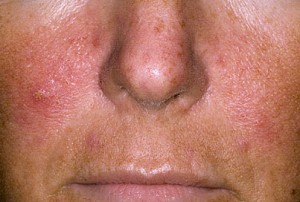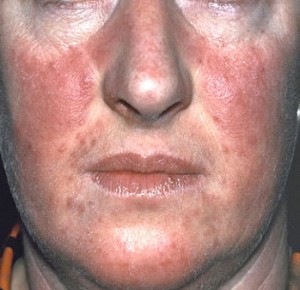Psoriasis is one of the most unpleasant skin ailments. The most common psoriatic lesions on the limbs and torso. Can psoriasis be on your face? Unfortunately, while a lot of unpleasant experiences for patients suffering from this disease.

Symptoms of psoriasis on the face
The initial stage of psoriasis on the face usually occurs in the late fall or winter. At this time, the skin becomes particularly vulnerable. A harbinger of the disease is itching. Symptoms of the initial stage of psoriasis on the face is very similar to a food Allergy or just irritation of the skin appear inflamed spots of small size (about pinhead size), localized mainly on the forehead or cheeks. However, over time they increase in size and merge to take the form of compacted nodules — papules having a pale shade of red. Especially intensively this occurs if the comb papules, which absolutely can not do because in their place can form scars. Gradually, the rash begins to cover the nasolabial triangle and the wings of the nose, frontal area, lips, penetrate into hair, spread to the ears, covering almost the entire front area.
Further signs of the disease can be described as "a combination of three phenomena":
- Plaques envelop soft scales;
- Further separation of scales beneath them is found red skin, as if covered with gloss (terminal protector);
- If you continue to scrape the skin, it begins to become damaged and to bleed small droplets of blood (blood Rosa).
In adulthood the most common is seborrheic psoriasis on the face psoriasis with a characteristic "crown" — a cluster of papules on the border of the hairy part of the head. Purulent crusts, which in this form, burst, causing quite severe pain. For children is more typical of the kind of psoriasis of the skin, called teardrop. Early in the disease it can be mistaken for a banal diathesis.
Causes
Psoriasis including the psoriasis on my face, not without reason, considered one of the most mysterious diseases. Debate about its etiology not subside until now. Among experts there are supporters of the primacy of the endocrine, autoimmune, psychosomatic theories, and lately becoming more and more popular genetic theory of the origin of psoriasis. To some extent this is confirmed by the ubiquitous statistics claiming that one in three of the four cases of this Dermatosis any of the close relatives is also a carrier. Does not cause much controversy among experts, perhaps only three circumstances:
- The disease is polietiologic nature to explain its origin reason fails;
- This pathology can for years, even decades to drive in a stable remission, but the final cure it comes;
- transfer of psoriasis is through direct contact is excluded: it is not contagious.
Whatever it was, but psoriatic rash that can cover almost any areas of the body, including those that are impossible to hide from the eyes of others, deliver psychological discomfort in the first place – the patient.
Types of psoriasis on the face
The disease has a quite complicated classification with a lot of varieties. The type of flow it can be divided into two large groups: those with pustular and pustular not flow. Interestingly, each species has its own "privilegium" the lesion. Especially not falling under the General classification of separate types, for example, seborrheal such manifestations. This fact helps doctors to conduct accurate diagnosis, therefore, to choose the optimal tactics of treatment.
Severity of occurrence of different light and heavy forms of psoriasis – depending on the total lesion size and systemic manifestations of the disease.
It should be noted that the face does not belong to the most typical areas of psoriatic lesions. In any case, the most typical seborrheic form of psoriasis vulgaris, which later extends to the border of the hairline and then, under it, producing, at first glance, seems ordinary dandruff.
The stage of the disease
Psoriasis on face is experiencing rapid development due to susceptibility of the skin in this area. On the initial stage of psoriasis on the face we have already described in detail. It is followed by a stage called stationary, when platelets become light shades, the form becomes rounded papules with silvery scales. Typically, these metamorphoses occur within approximately one month after the occurrence of the disease.
The next stage is considered to be decaying. At this stage, the plaque almost does not stand out on the skin and pale. The desire to brush it passes, papules cincta dense and labrum corneum. This process continues, on average, from two to six months.

How to treat psoriasis on the face?
Treating disease engaged a dermatologist, and at the first suspicion on psoriasis visit to it should not delay: how long before he starts treatment, so faster facial psoriasis go into remission. At the same time, it is necessary to understand that psoriasis treatment is a long and complicated process. Any miracle remedies do not exist, and therapy provides a comprehensive solution with the use of different mechanisms of action.
Ointment for psoriasis on the face
The most effective way of dealing with the disease are external funds in the form of balms, lotions, creams. Wide application due to its effectiveness find ointments for the face from psoriasis: how hormonal, and do not contain hormones. In this case, the first have a strong, but short-term exposure, since they quickly lead to addiction and the subsequent new round of escalation. Hormonal drugs treat, mainly psoriasis on the face in adults. Non-hormonal also work gradually, however provide remission for a longer period.
Than to smear the face from psoriasis?
The following non-hormonal remedies for the treatment of psoriasis of the skin:
- for the removal of peeling apply salicylic ointment, and combined salicylic -zinc gives anti-inflammatory effect and dries the skin affected;
- excellent anti-inflammatory indications have ointments, in which there is tar or grease;
- ointment of zinc protects the skin from the negative effects of the external environment, reduces swelling, fights inflammation;
- the overwhelming effects on the diseased cells have ointments containing vitamin D;
- antipruritic effect is famous for oil-containing drugs, which is especially important when the acute phase of the disease is ended and begins the healing;
- to moisturize skin apply ointment based on herbal extracts with a content of calendula, celandine, chamomile and other medicinal plants.
Hormonal ointments vary in its impact from relatively mild to more powerful.
As a rule, ointments for the face from psoriasis should be applied before bedtime, when the body is in complete rest – however, the therapeutic effect is much higher.
Due to the many side effects of hormonal drugs should be used with great caution and only after instructions of the doctor. Self-treatment is strictly prohibited – it can lead to irreversible health effects.
Procedural therapy
In addition to these drugs will apply to physiotherapy.
Great sedation give daily sessions electrosleep, continuing from 20 minutes to half an hour for at least weeks. Photochemotherapy and ultraviolet rays determined by the doctor during the periods of attenuation of disease and contribute to increase the time of remission. In some cases, can be assigned x-ray irradiation of the affected areas. Safer is considered to be laser therapy.
A great addition to the basic treatment is the health resort therapy.
Medication
As for drugs, they are prescribed only in obsolete and advanced forms in the treatment of seborrheic psoriasis on the face. These tools include, in particular:
- cytotoxic agents that slow down the division epitelyarnyh cells, e.g., methotrexate;
- immune depressant type And cyclosporine, which suppress the occurrence of autoimmune processes;
- corticosteroids for internal use;
- biologically active substances and alefacept Avastin that block the reproduction of abnormal cells.
Taking all of these drugs is carried out only under medical supervision.
Folk remedy for psoriasis on the face
Treatment of psoriasis on the face folk remedies also gives a positive result, but only when used under the supervision of a physician and combined with other methods of combating the disease. The basis of traditional medicine – natural ingredients, so they are recommended even in the treatment of children. Recommended to all kinds of herbal tinctures, baths with medicinal decoctions, ointments and masks for facial psoriasis, cooked "grandma's recipes". For example, soothe skin salt mask imposed on pre-cleaned face (best suited sea salt), tar, masks and ointments. Good effects of sea buckthorn oil, which has both the external and internal use, as well as lavender and coconut oil. It is recommended the consumption of vegetables that contain carotene, pumpkins, fruits with red and orange color. A certain result is also given homeopathic remedies.
Despite the complexity of the disease, the main part of the treatment of psoriasis on the face is made at home (with rare exceptions). The importance of accurate implementation of medical guidelines, including:
- careful hygiene of the skin and protection it from all kinds of negative impacts: mechanical, climatic, ecological;
- diet especially during periods of exacerbation of psoriasis on the face. Should completely refrain from irritating and allergenic products, tobacco and alcoholic products;
- periodic visit of dermatologist
And now the answer to the main question: how to get rid of psoriasis on the face?
Unfortunately, to cure the disease completely impossible. However, carrying out doctor's orders, respecting preventive measures and supporting the right mental attitude, it is possible to increase the duration of periods of remission, maintaining a high quality of life.























